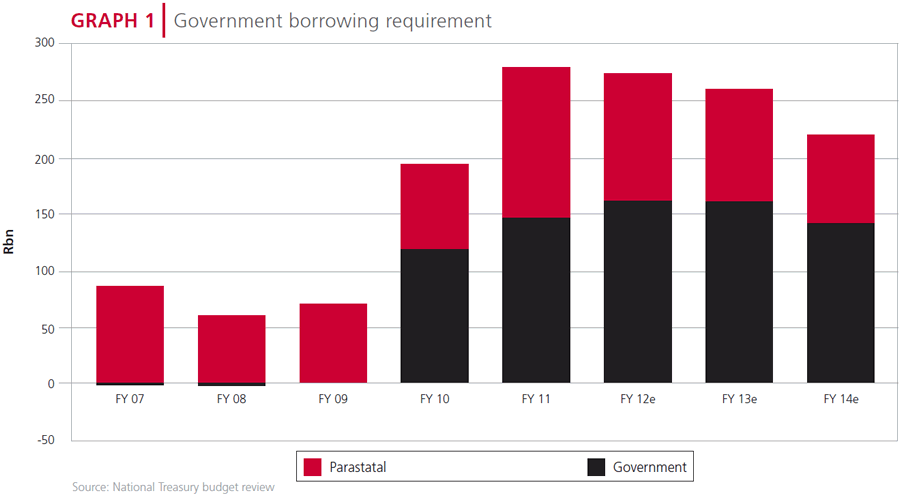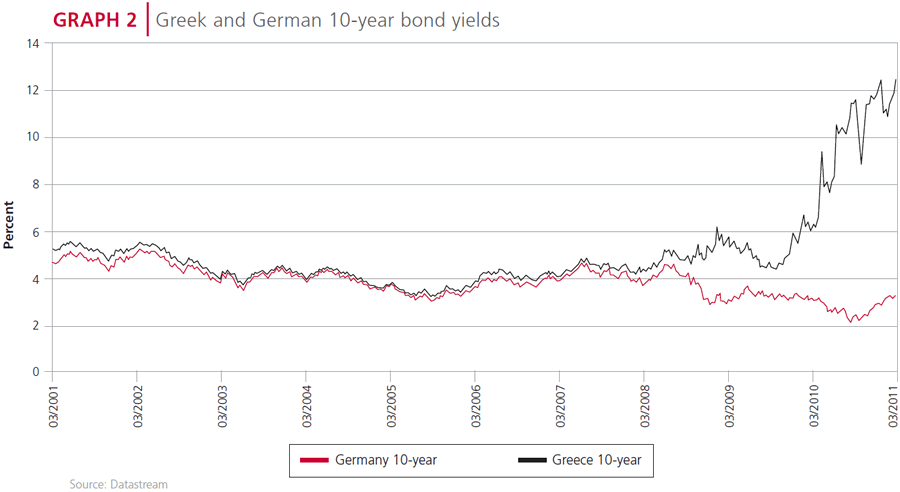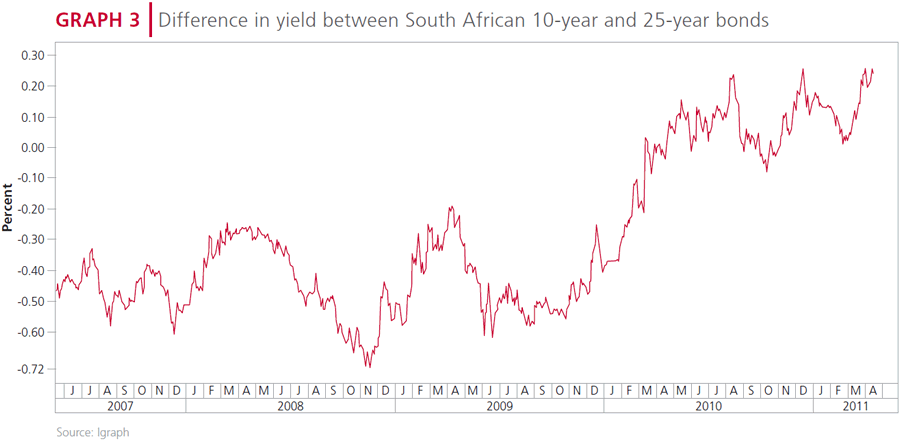As a bond investor you need to ask yourself two questions: are your inflation expectations reasonable, and will the potential real return be sufficient? Andrew Lapping explains why it is important to take a long-term view and consider the full life of the bond.
South African 10-year bond yields rose sharply over the past six months to 8.9%. A yield of 8.9% seems to be a fairly attractive proposition compared with cash yielding 5.4%. Unfortunately in the bond market, as in life, it is not that simple.
When buying a 10-year bond the question is not what is the pick-up on cash or inflation today, but rather what will the pick-up be over the life of the bond? The reason is, when buying a 10-year fixed rate note, the difference between the initial yield and inflation over the 10-year period determines the real return. If investors require a 3% real rate of return on their money, a 10-year interest rate of 8.9% indicates an expected inflation rate of 5.9% over the period.
As the investor you must ask yourself two questions: firstly, is an anticipated inflation rate of 5.9% a reasonable expectation and secondly, is a 3% real return sufficient?
Inflation outlook
In a small, open economy like South Africa's, the exchange rate is a key inflation driver as imported cost inflation is quickly passed on to the consumer. Over the past 10 years the rand has strengthened 10% against the US dollar, from R7.70/US$ to R6.90, while at the same time weakening 26% against the euro. The general trend of a strengthening currency has been a substantial tailwind in keeping inflation down. From here it is hard to see this tailwind being maintained over the next decade, and the more likely scenario is a weaker currency. This is because the rand is now relatively strong in terms of purchasing power parity against a basket of currencies. If the rand weakens only gradually, in line with inflation differentials, the South African Reserve Bank (SARB) will no longer have the benefit of a strengthening currency. Considering inflation averaged 5.9% over the past 10 years, just inside the target range, the outlook for the next 10 years is less positive.
IN ADDITION TO THE INFLATION CONSEQUENCES OF A WEAKER CURRENCY, THE STEADY INCREASES IN ADMINISTERED PRICES ARE PUTTING UPWARD PRESSURE ON INFLATION
In addition to the inflation consequences of a weaker currency, the steady increases in administered prices are putting upward pressure on inflation. Administered prices, excluding fuel, are currently increasing by 9%, a level not compatible with a long-term inflation rate of below 6%. For example, many listed property companies in South Africa are reporting property occupation cost increases of over 15% due to higher rates and electricity costs. These administered price increases flow through into the cost of doing business in South Africa, which the anecdotal evidence, together with reported wage settlement data, suggest is increasing at a rate well in excess of headline CPI. Unless real wage and administered price increases can be offset by substantial productivity gains, South Africa will not be able to maintain a low and stable inflation rate.

What real return will South African government bond investors require?
Two metrics guide any estimate: (1) the historical real government bond yield, which has averaged 3% since the inflation targeting regime began in February 2000, and (2) the real yield on inflation linked bonds (currently 2.7%). A caveat to this is that inflation linkers have a slightly different risk profile from nominal bonds as your capital is protected in high inflation environments, while the capital losses on nominal bonds can be substantial.
A real return of 3% over the long term is an attractive proposition for non-tax paying investors like South African pension funds. Real return is determined by supply and demand: the demand for government debt comes from savers/investors and financial institutions, while the supply is determined by government borrowing. Government borrowing, including parastatals, has picked up recently because of the increasing budget deficit and the infrastructure investment programme (Graph 1). In 2009 government borrowing requirements could be satisfied from the reinvestment of interest and flows into private and public pension funds. Worryingly, the personal savings rate in South Africa is close to zero so the net flows into savings products are limited. These flows are no longer sufficient to meet the government's borrowing requirement.
During 2010 the demand was met through pension funds shifting their asset allocation towards bonds and the inflow of funds from foreign investors. Foreigners invested a net R84bn into South African debt and equity markets last year. The increased borrowing requirements over the next three years will require a further asset allocation shift and foreign investment. Positive sentiment towards emerging markets from international investors has led to the substantial net flows into South African assets over the past two years. If this sentiment, and hence the flows, reverses, it will put pressure on the government bonds as a big source of demand will disappear. For context, the sum of parastatal and government bonds outstanding is R855bn. This compares with a budgeted additional borrowing requirement of R275bn from these institutions in FY2012.
It may be the case that higher real yields are required to entice investors to move capital from other asset classes into government debt. The shift in yields, if it occurs, may be gradual or take the form of a phase shift where the situation rapidly changes from one where there are sufficient buyers to one where there is a paucity of demand. The Southern European countries are a good example of this. Anyone who took a careful look at the Greek fiscal and economic data could see the situation was unsustainable, or at the very least that the quality of Greek credit was worse than Germany's, but the spread between Greek and German government bonds was very narrow until investors suddenly decided the situation was untenable (Graph 2). This example is not to say the South African fiscal situation is unsustainable, but rather that the market sometimes ignores certain things until suddenly it decides not to.
WE THINK IT IS VERY DIFFICULT TO MAKE MONEY OUT OF SHORT-TERM VOLATILITY IN THE BOND MARKET
The increased government issuance may also cause the term structure of interest rates to change. Historically South Africa has had an unusually flat yield curve from the middle area of the curve to the long end. This was caused by a shortage of the long-dated bonds that insurance companies use to hedge their liabilities. Now that the issuance of long bonds has increased, the term structure has begun to normalise as the supply has satisfied demand.
Logically it seems right that a 25-year bond should have a higher yield than a 10-year bond, if you just think about what can happen over 25 years, a lot can change that can affect the value of your asset. In the United States the 30-year bond has traditionally yielded about 0.6% more than the 10-year. In contrast, until very recently the yield on 10-year government bonds was higher than that on 25-year bonds in South Africa (Graph 3). This favours the shorter bonds over the long-term assets, as investors are not compensated suitably for the additional risk of the long bonds.

 Our long-term strategy
Our long-term strategy
It may seem overly cautious to focus on the inflation outlook and expected real rates over the next decade when there seem to be opportunities to make money out of short-term volatility. Yet, we believe this is the correct strategy, as we think it is very difficult to make money out of short-term volatility in the bond market. Rather we attempt to get the big trends right, and the only way to anticipate these big trends is to take a long-term view of fair value and always be cognisant of the risks.